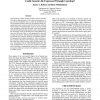Free Online Productivity Tools
i2Speak
i2Symbol
i2OCR
iTex2Img
iWeb2Print
iWeb2Shot
i2Type
iPdf2Split
iPdf2Merge
i2Bopomofo
i2Arabic
i2Style
i2Image
i2PDF
iLatex2Rtf
Sci2ools
AAAI
2000
2000
Self-Organization of Innate Face Preferences: Could Genetics Be Expressed through Learning?
Self-organizing models develop realistic cortical structures when given approximations of the visual environment as input, and are an effective way to model the development of face recognition abilities. However, environment-driven selforganization alone cannot account for the fact that newborn human infants will preferentially attend to face-like stimuli even immediately after birth. Recently it has been proposed that internally generated input patterns, such as those found in the developing retina and in PGO waves during REM sleep, may have the same effect on self-organization as does the external environment. Internal pattern generators constitute an efficient way to specify, develop, and maintain functionally appropriate perceptual organization. They may help express complex structures from minimal genetic information, and retain this genetic structure within a highly plastic system. Simulations with the CRF-LISSOM model show that such preorganization can account for newborn face ...
AAAI 2000 | Face Recognition Abilities | Intelligent Agents | Minimal Genetic Information | Realistic Cortical Structures |
| Added | 01 Nov 2010 |
| Updated | 01 Nov 2010 |
| Type | Conference |
| Year | 2000 |
| Where | AAAI |
| Authors | James A. Bednar, Risto Miikkulainen |
Comments (0)

